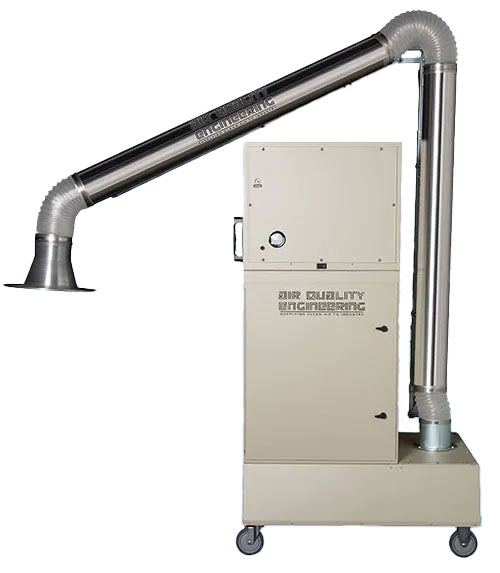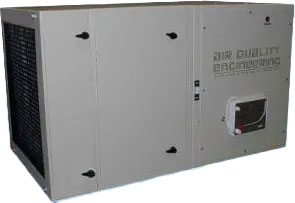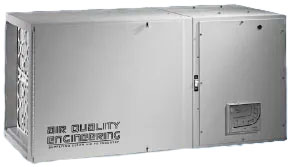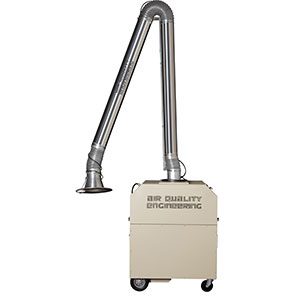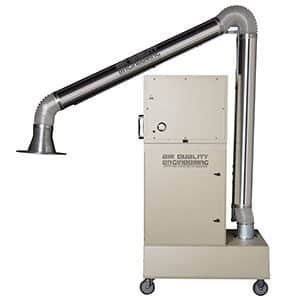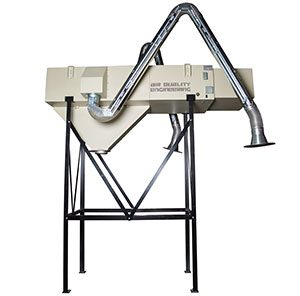Speak to an Air Purification Expert
Speak to an Air Purification Expert
Welding Fume Extractors and Welding Shop Air Filtration Systems
Overhead, Ambient, and Portable Welding Fume Extractor
Protect your welders and your workflow with advanced welding fume extractors. Air Quality Engineering, Inc. designs welding shop air filtration systems that remove hazardous fumes at the source while keeping productivity high. From portable welding fume extractors to overhead and ambient units, our solutions are engineered to safeguard worker health, meet OSHA standards, and maintain efficient shop operations.
Practical Solutions for Welding Health Hazards
Modern welding processes such as SMAW (stick), FCAW (flux core), and GMAW (MIG) produce hazardous fumes, even when working with common carbon steel. Research has highlighted exposure risks from manganese, chromium, nickel, and other toxic metals. OSHA’s regulations on hexavalent chromium (CrVI) underscore the need for safer environments. With many welders reluctant to wear respirators under their hoods, shops require better solutions to remove fumes directly from the breathing zone.
Fume extractor welding systems provide reliable, scalable ways to protect workers and keep your shop compliant. AQE offers three air cleaning technologies tailored for welding environments:
- Electrostatic units: Permanent collector cells for high efficiency and no filter replacement costs.
- Media filtration units: Options include bag filters, pleated filters, and HEPA filters for fine particulate capture.
- Cartridge systems: Reverse pulse technology for high-production environments with heavy fume loads.
Each technology is available in portable, ambient, or overhead ducted configurations to match your shop’s needs.
Welding Fume Extractor Product Line
Portable Welding Fume Extractors
Protect welders on the move with mobile source capture. Portable units like the Porta Air™ deliver high-efficiency filtration right where it’s needed, making them ideal for shops with changing setups or multiple stations.
View Portable Welding Fume Extractors
Key Features:
- Mobile design for flexible fume extraction.
- Available with electrostatic, media, or cartridge filtration.
- Capture fumes at the source to protect welders.
- Easy to position with source capture arms.
- Durable construction for industrial use.
Ambient Welding Shop Air Filtration Systems
Reduce overall fume levels across your entire welding shop. Ambient, or “general background” air cleaners continuously circulate and clean background air, making them effective for multiple or dispersed welding stations.
Key Features:
- General background filtration for large welding areas.
- Options for electrostatic, media, or cartridge systems.
- Keeps airborne fume levels low across the shop.
- Reduces reliance on personal protective equipment.
- Designed for continuous operation.
Product Highlight: M66 Air Filtration Media System
M66 Air Filtration Media System is a powerful media-based system with a 360° rotating overhead source capture arm, giving shops the flexibility of both ambient and localized fume extraction.
View the M66 Air Filtration Media System
Overhead Welding Fume Extractors
Overhead ducted systems deliver source capture while conserving floor space. These units can be paired with source capture arms to pull fumes directly from the welding arc, protecting welders’ breathing zones and maintaining shop airflow.
Key Features:
- Overhead design conserves valuable floor space.
- Effective source capture from the welding arc.
- Compatible with source capture arms.
- Available in multiple filtration technologies.
- Built for high-volume industrial environments.
Product Highlight: AQE4000 Reverse Pulse Jet Dust Collector
AQE4000 Reverse Pulse Jet Dust Collector offers twin fume extraction arms and reverse pulse cartridge cleaning, ideal for heavy-production welding shops that need long maintenance intervals.
View the AQE4000 Reverse Pulse Jet Dust Collector
Partner with AQE
With decades of expertise in air purification, Air Quality Engineering is the trusted partner for welding shops that need reliable air filtration. Our systems are designed to improve worker safety, reduce compliance risks, and keep operations efficient. By choosing AQE, you gain industrial-grade performance, responsive support, and long-term reliability.
Frequently Asked Questions
What is the best welding fume extractor for my shop?
The right solution depends on your setup. AQE offers portable welding fume extractors for mobility, ambient systems for whole-shop coverage, and overhead units for direct source capture.
Do welding fume extractors meet OSHA standards?
Yes. AQE systems are engineered to help shops meet OSHA regulations, including standards for hexavalent chromium exposure.
How much does a fume extractor welding system cost?
The cost of a fume extractor welding system depends on the model, number of units, and selected features. All AQE units are manufactured in the USA, helping to control costs and ensure quality. For a tailored quote, contact AQE directly — most systems have short lead times, and our team will guide you to the right solution for your shop.
How often do filters need replacement in welding shop air filtration systems?
Electrostatic models feature permanent collector cells that can be washed and reused, while media and cartridge systems use disposable filters. Maintenance intervals depend on fume volume and usage.
Do welding fume extractors really work?
Yes, fume extractors work when the collector arm is properly placed near the work area. The air is filtered and returned to the shop area. When a shop is heated or cooled, they do not remove the conditioned area.
How do welding fume extractors work?
Fume extractors work by pulling weld fumes into the collector hood when properly placed near the work area. The air is filtered and returned to the shop area. When a shop is heated or cooled, they do not remove the conditioned area.
What is the flow rate for welding fume extraction?
Flow rates vary with size, ranging from 1,100 to 3,000 CFM.
What applications do welding fume extractors work best for?
Fume extractors work for all applications. However, some applications may require a HEPA or a carbon filter.
Do you need a fume extractor for welding?
That varies with the amount of welding being performed and the location. It is the healthy choice for welding indoors.
How close should my fume extractor’s hood be to the welding arc?
There is no specific distance or alignment requirement for the extractor hood. It should have the proper CFM to allow enough room, so it does not interfere with your work and the fumes are visibly pulled into the hood.
Why should I use a fume extractor instead of an ambient (overhead) air cleaner?
Fumes are removed faster and more efficiently. A smaller unit can also be used.
Why should I use a fume extractor instead of wearing a respirator?
The fume extractor will filter the fumes out of the room, where the respirator will not, and the fumes will still be present when the mask is removed.
How do excessive amounts of manganese affect a weld? Or a welder?
Excessive amounts of manganese in a weld can significantly strengthen the weld metal, but at the expense of its ductility, making the weld more brittle and susceptible to cracking, essentially making it too hard and less flexible; this is because manganese acts as a hardening agent in steel when present in large quantities.
In the welding industry, manganese is incorporated in consumables, such as rods and wires, for three types of welding processes: Shielded Metal Arc Welding or “Stick” Welding, Gas Metal Arc Welding or “MIG”, and Flux Core Arc Welding. This can expose a welder to manganese during welding.
According to the Centers for Disease Control and Prevention (CDC), “A healthy person with normal liver and kidney function can excrete excess dietary manganese.” However, when this mineral is inhaled, it bypasses the body’s normal defense functions and can cause adverse health effects to the central nervous system.
Additional Resources
- Portable Welding Air Cleaner Video
- OSHA Welding Resource Center
- Manganese in Welding Fumes: The Adverse Health Effects & How to Reduce Them
- Risks Of Hexavalent Chromium Overexposure
- The Health Hazards of Manganese on Welders
- Positioning Of The Source Capture Hood During Welding
- Welding Hazards and Your Workplace
- Good Choices For Weld Fume Collection
- Overcome Weld Fume Collection Issues
- New Weld Fume Collection Arm


